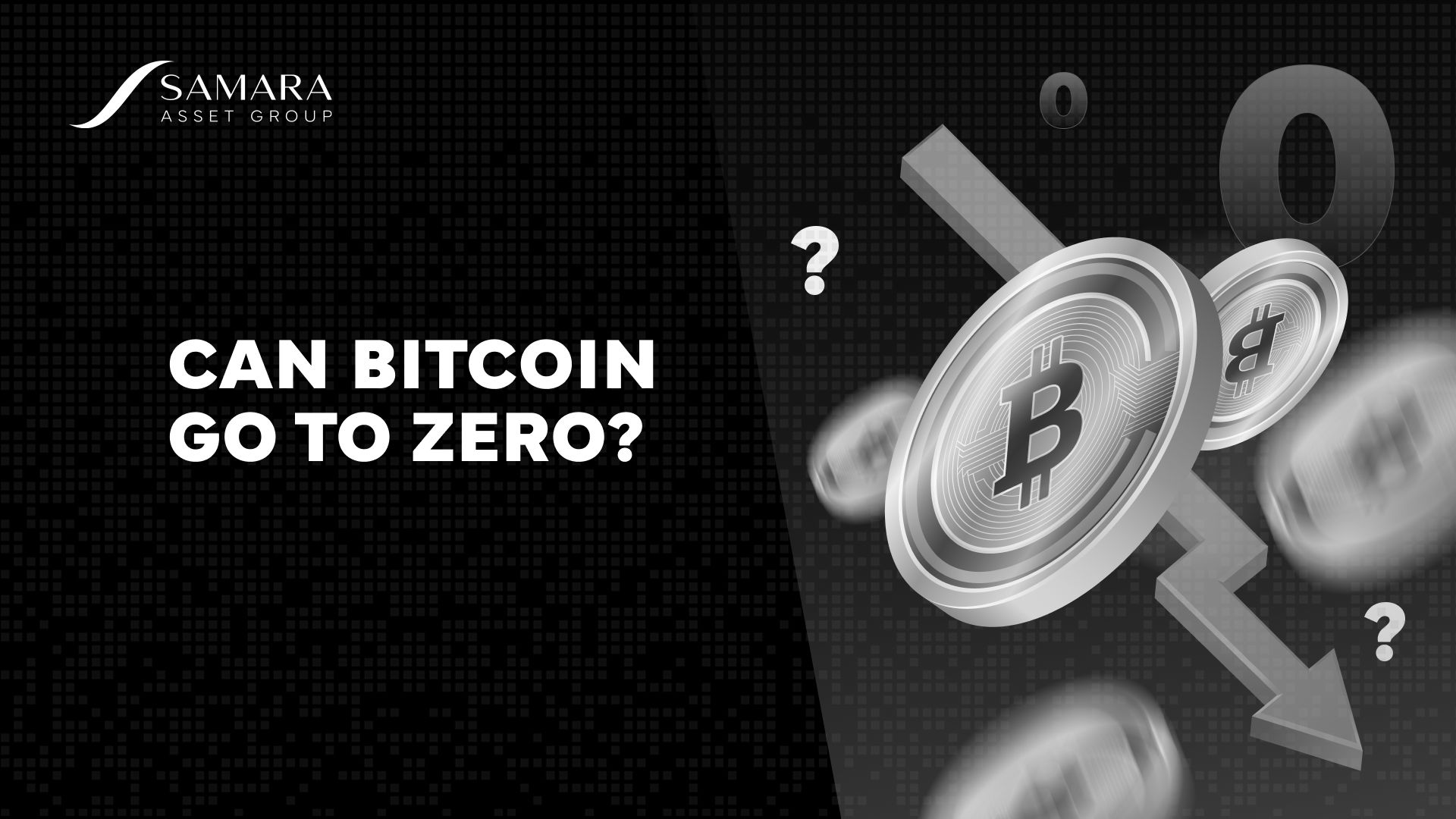Bitcoin
Bitcoin CPI
Venture Portfolio
Funds
Market Insights
Indicators
About
Contact

July 31, 2025





Despite the price of Bitcoin (BTC) having been successful in hitting new all-time highs after each bear market, one question in certain circles, especially among Bitcoin critics, keeps emerging: can Bitcoin go to zero?
As Bitcoin technology continues to expand, this question more and more resembles the question of whether time travel is possible–in theory, yes, but in practice, it’s not very likely.
In this article, we’ll explore what gives Bitcoin value and why it’s extremely unlikely for the price of Bitcoin to go to zero at any point in the future.

Bitcoin, as a technology and an asset, derives its value from its properties, such as decentralization, censorship resistance, and scarcity, among others.
It allows anyone in the world with an internet connection to transfer value without an intermediary. Moreover, in some instances, it can be done cheaper and faster than by using traditional finance infrastructure.
Bitcoin’s value, in terms of price, is determined by the fundamental yet simple market rule: supply and demand.
Let’s explore this crucial dynamic and how it’s now being shaped.
First, Bitcoin has a limited supply of 21 million coins. This makes BTC one of the scarcest assets in the world, and is one of the key factors to Bitcoin’s value.
In contrast, there can be an endless supply of fiat money, such as the US dollar, which is debased by continuously “printing” new supply.
Currently, newly generated BTC enters the market at around 0.8% annual inflation rate, which is less than gold. Moreover, around every four years, a Bitcoin halving occurs and reduces the supply of new Bitcoin generated by miners by half.
Therefore, as the total number of BTC is capped while the issuance is sharply decreasing, the main BTC supply for investors comes from already existing coins in the market.
Following the rules of supply and demand, the continued increase in Bitcoin adoption and market demand exceeds its supply, therefore increasing BTC's fiat-denominated price.
Now, the demand mainly depends on two factors: investor sentiment and global adoption of Bitcoin.
Throughout the 16 years of Bitcoin’s existence, demand for BTC kept growing. However, with the launch of spot Bitcoin ETFs (exchange-traded funds) in the U.S. on January 11, 2024, investor sentiment amongst traditional institutional and retail investors exponentially grew, helping BTC strengthen its position as an alternative asset.
As of July 2025, Bitcoin ETFs hold $135.71 billion, or 6.32% of the total BTC supply. By comparison, the wallet linked to Bitcoin’s anonymous creator, Satoshi Nakamoto, holds roughly 5.23%.

This change in perception set the stage for Bitcoin among financial institutions, hedge funds, pension funds, and other traditional investors. In response to demand, given its increased legitimacy, financial advisors started to offer BTC investments via ETFs more freely. This had global implications by further improving investor sentiment toward BTC.
In addition to its growing acceptance among institutional and retail investors, Bitcoin continues to gain global traction.
As Bitcoin operates 24/7, is highly liquid, and has no central authority, such as a central bank or a government behind it, it’s very appealing as an alternative for both domestic and international transactions. Also, technological improvements, such as Lightning Network, make Bitcoin a payments network, while its price volatility keeps decreasing.
Bitcoin is also considered a store of value and protection against currency debasement, especially in countries with less stable monetary systems. In fact, there are plans by numerous countries, including the U.S., to launch their own strategic BTC reserves.
In the context of improving investor sentiment and growing global adoption, we can ask the following question:
Since its inception in 2009, Bitcoin has experienced multiple drawdowns, sometimes even more than 80%. However, it has always recovered to new highs.
But still, can its price go to zero in USD terms?
While nothing in this world is guaranteed, it’s highly improbable that this could happen with Bitcoin.
For that to happen, BTC should lose all its properties and no one in the world would see value in it. Moreover, many Bitcoiners joke that they would buy all the BTC should its price drop near zero.
In theory, such a crash might happen in a doomsday scenario when the technology fails miserably, the network is attacked, a critical vulnerability is exploited, or all governments of the world ban this technology. Also, in theory, another scenario is that Bitcoin whales, including mysterious Bitcoin creator Satoshi Nakamoto, for some reason would sell their entire BTC portfolio, creating immense selling pressure.
While these worst-case scenarios could negatively affect the price of BTC severely, it’s very unlikely they would push Bitcoin to zero.

The number of critics and media headlines calling Bitcoin another asset bubble and predicting it going to zero is decreasing yearly. And for good reason, as BTC is increasingly legitimized after proving its resilience during its turbulent 16 years of existence.
In its early days, BTC had the occasional 25% drop in a day, but with time and more users in the network, these numbers steadily decreased.
While it’s still volatile, especially compared to traditional markets, its volatility has been on the decline in the past 15 years.
This historical resilience is also visible in Bitcoin’s on-chain data, where new wallets, addresses, and users enter the network after each bear market.
As mentioned previously, Bitcoin is being increasingly adopted by leading financial institutions, including the world’s largest asset manager by AUM, BlackRock, which now operates the biggest BTC ETF.
Moreover, this adoption continues as more publicly traded companies announce dedicated Bitcoin treasury strategies.
The newest addition to this adoption might be one of nation-states, with countries such as El Salvador recognizing BTC as legal tender, while the Kingdom of Bhutan is becoming one of the top Bitcoin miners.
Meanwhile, should the U.S. move forward with its Strategic Bitcoin Reserve, this might prompt a global race among nations to build their own BTC reserves.
The chances of Bitcoin going to zero are … almost zero.
A worldwide catastrophic event would be necessary, and all existing holders and capital allocators would need to sell instantly, or the whole network would need to crash without any chance of recovery.
Moreover, Bitcoin is designed in a way that is more profitable to help the network succeed, for example, by mining, than to attack it.
Meanwhile, quantum computing is also often listed among the crucial potential threats as it, in theory, could be able to attack the network and steal BTC from Bitcoin whales. However, traditional finance infrastructure is arguably more vulnerable to such attacks, while Bitcoin developers are already working on quantum computing-resilient solutions (just in case).
This means that the price of Bitcoin, denominated in fiat currency, such as U.S. dollars, would be at zero or close to zero. However, given the current state of the network, investor sentiment, and growing adoption, it’s extremely unlikely for this to happen.
Bitcoin retains its value during market downturns due to its supply and demand dynamics. During all previous sharp sell-offs, BTC was always able to find sufficient demand that would stop the price from going lower and propel it to new all-time highs, as investors believe in this technology and its future potential.
It’s highly unlikely for Bitcoin to drop to zero. Even in the steepest price corrections in the past, the world’s leading digital currency never lost all its value. Demand from institutions, corporate treasuries, and long-term Bitcoin holders helps to support the price. That growing demand combined with Bitcoin’s fixed coin supply has helped the cryptocurrency to increase in value of time, albeit with period of high volatility.
Bitcoin’s price can drop due to market volatility caused by idiosyncratic news, macroeconomic shifts, or regulatory changes. However, a complete loss of value is highly unlike at this point as the cryptocurrency has matured into an established alternatgive asset.